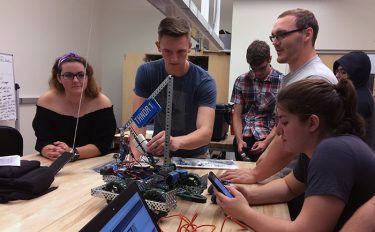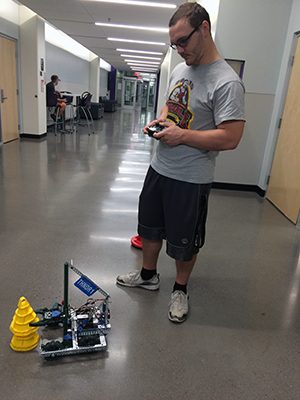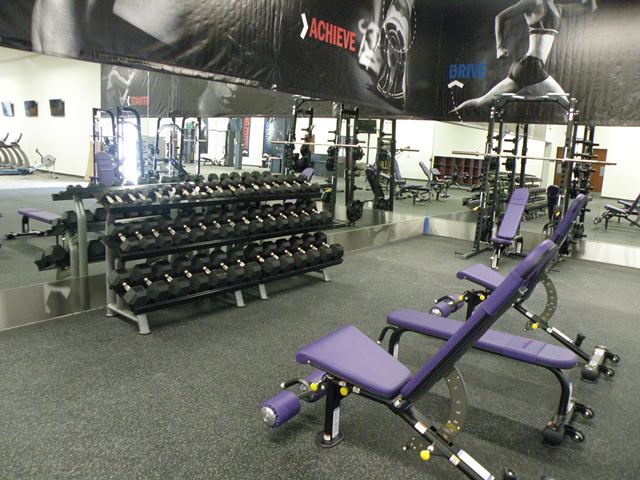
Story and photos by Lana Sweeten-Shults
GCU News Bureau
The weather outside was basketball.
But the GCU Robotics Club wasn’t having any of it. Never mind the electricity and frenetic energy in the air generated by a winning basketball team's return to court.
“We have a competition of our own to get ready for,” sophomore engineering major Makayla Jewell said on the second floor of the College of Science, Engineering and Technology. She was steely-eyed and focused on the task at hand, even as the rest of the campus, abuzz outside with utter gleefulness during pregame festivities, waited anxiously in line to get into GCU Arena for the first men’s basketball game of the season.

Since early October, the 30-plus member club had gone into eye-of-the-tiger mode, preparing for “THE GREATEST TWO MINUTES IN ROBOTICS!” (insert boxing announcer voice here) – well, it's the greatest two minutes in robotics, at least according to VEX Robotics when it describes its "In the Zone" competition.
The regional event, held Saturday at Embry-Riddle University in Prescott, would be the first competition for the newbie Robotics Club, formed just last school year and chartered in February.
“Last year, we were just a start-up club. We laid down the bylaws and did a little bit of fundraising,” Jewell said.
This year, the club is upping its game – and its nerd-to-science-to-cool factor, of course.
While the group usually meets just once a week, leading up to the competition, it got together three times a week for two to three hours at a time.
Like Dr. Frankenstein marveling at his creation, the club, too, can now boast, “It’s alive!” when it comes to its first robotic creation, affectionately dubbed Thunderbot. The gear-filled build spanned nine weeks, with the team limited to building an 18-inch X 18-inch X 18-inch ’bot. It was through a grant from VEX that the team was able to land its initial robot kit, packed with the metal and plastic pieces used in the build.
“It was a pretty generic idea with what we started with,” Jewell said. “ … We didn’t want to do something too elaborate.”
Not that the team didn’t want to do something a little more wild and crazy.

“One of our craziest ideas would be an arm in the center of the robot so it could rotate from front to back … but that was just too unfeasible,” said mechanical engineering major Matthew Hopper, who was busy tightening up Thunderbot's bolts.
The team didn’t have to worry about its robot battling fellow 'bots to the death in gladiator Colosseum fashion. The VEX competition – one of the few robot competitions for those on the collegiate level – was not about competitor robot annihilation. Rather, it’s task-oriented.
GCU’s electro-mechanical Thundebot, touting a blue flag that reads THNDR1, zips along the floor of CSET, its four green tires churning along below a steel square base from which emanates a jumble of black yellow and red wires and a vertical arm.
A gaggle of bright yellow cones pepper the floor, with a larger red cone on the side.
“ZZzzzzzuuhhhZZZzzz!!!” Thunderbot squeals as its driver, mechanical engineering major Talon Birdsong, controls its direction and its claw-like arm, inching the arm forward as it pinches closed on one of the yellow cones before scuttling, cone in hand, to the red cone.
That’s where it deposits the yellow cone snugly on top of the red one.
It’s just one of the tasks Thunderbot must do for the VEX competition, a two-minute flurry of cool-robot-sciencey-excitement.
Collegiate teams have 45 seconds to score points during an autonomous period, meaning the robot controls itself. The club's programmers were able to get autonomous mode working just two days before the competition. The 'bots then have 1 minute 15 seconds to rack up points during the driver-controlled period. Robots converge on a 12- x 12-foot field, with participants scoring points for stacking cones on goals – 80 cones can be stacked on 10 goals – placing mobile goals in goal zones, having the highest stacks and parking the robots, with a bonus awarded to the team with the most total points at the end of the autonomous period.
And then there’s the portion of the event that doesn't involve cone-stacking, which is where GCU electrical engineering technology instructor and Robotics Club faculty advisor Ed Koeneman comes in.
Koeneman ran his own medical device company, Kinetic Muscles, for 15 years and spent many years supporting his own children in robotics competitions. He spent the first 15 minutes of the Robotics Club meeting giving students a pep talk.
Part of the challenge in the competition is for the team – some are in charge of programming, others oversee such tasks as documentation and social media – to be able to answer the judges’ questions confidently.
“The judges come into the pits and interview the team, and everybody has to answer the questions,” he said.

Judges also look at their robotics log, which documents what the team did to engineer its robot.
“You’ve got to tell a story,” Koeneman said. “… They’re trying to teach these good engineering skills and have fun doing it. A big part of engineering is documentation and communication.”
After this first event, the members of the Robotics Club will have until March to prepare for its second competition – and vie for a place in the world championship. They also will spend time raising funds – they don't have a corporate sponsor.
It costs about $3,000 a year to run a robotics team, Koeneman said, adding how the club has received support from CSET Associate Dean Dr. Michael Sheller and the Associated Students of GCU, who have been “very generous in their appropriations.”
“A corporate sponsor would be very helpful,” he said. Until then, the club is planning a Valentine’s Day fundraiser and is just enjoying the company of its fellow robotics enthusiasts. Of course, it's also basking in the glow of competition.
At the In the Zone event, Birdsong popped Thunderbot into wheelies to try to stack as many yellow cones as possible, then pushed red cones into designated goal zones to score more points. Just as with GCU basketball fans on the opening night of the season, the room, peppered with laptops and robot science warriors, was abuzz and filled with utter gleefulness as frenetic energy filled the air.
Thunderbot won several matches before landing a spot in the quarterfinals. That's when GCU fell in the first playoff round.
It was a solid showing for the team, which knew of its robot's limitations before the competition and took what it learned – some 10 pages of notes – back to the lab to tweak Thunderbot.

Club vice president Doris Gamboa, an electrical engineering major, said she always has thought robotics was “a cool thing to do” and just wanted to have fun at the team’s first competition.
But ask her which team she was looking forward to beating. She just said, “Um, everyone," with a smile.
Not that the Robotics Club is limited to engineering majors, such as Gamboa. It includes everyone from premed to business and forensics students, too.
Birdsong, who comes from a small high school with a graduating class of about 50, said his school didn’t have the funding for robotics. “But I always wanted to do it. I like the friendly community aspect of it, getting out there and making new friends with similar interests.”
As for Jewell, who wants to build prosthetic hearts in her post-GCU career, said, “I just have a passion for robots. I think competing competitively, particularly in something pertaining to your major, is important. … And we want the community to see how much STEM (science, technology, engineering and math) is growing.”
Contact GCU senior writer Lana Sweeten-Shults at (602) 639-7901 or [email protected]. Follow her on Twitter @LanaSweetenShul.















